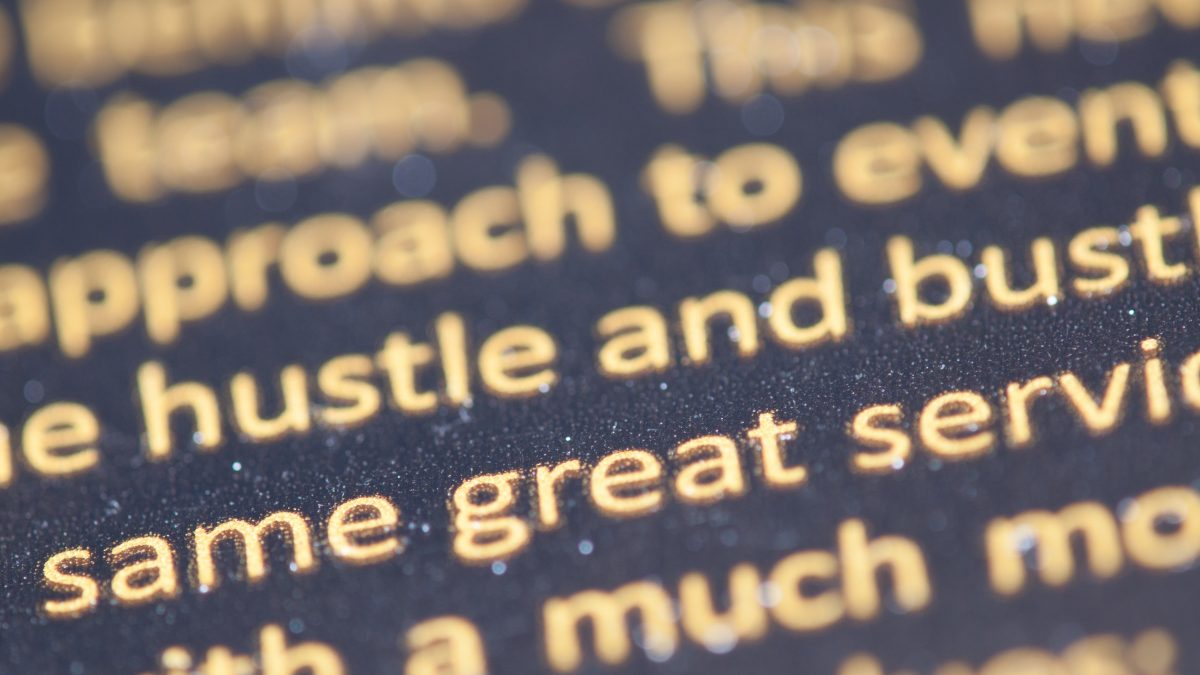The Ultimate Typography Guide
Typography affects everything, from readability to trustability. And a poorly chosen font can undermine even the most compelling piece of marketing. Because typography expresses more than just words — it can reveal a brand’s personality, values, and aesthetic tastes.
Luckily, however, understanding the basics of typography and how to use it well is relatively straightforward. So in this post we’ll look at some of the best practises when it comes to all things typographical, along with a few simple tips and tricks to help to make choosing your next font quick, easy, and fun.
Typography is an integral part of design
Photo by mali maeder from Pexels.
First things first: it’s a huge mistake to assume that typography and design are separate things. They are, in fact, two parts of the same whole, and one can’t work without the other.
So choosing a typeface that fits the aesthetic of your project is essential. Because it’s easy to overlook the impact fonts have on readers, but in the end they can make or break a design’s success.
When it comes to typography, then, be sure to incorporate it into the barebones of your design, whatever the design may be. Consider how the fonts affect the visuals, and vice versa.
Remember that poorly considered fonts can detract enormously from the overall quality of effectiveness of your designs. But carefully chosen (and creatively applied) fonts can add huge value to any piece of marketing.
Words to match the project
The typography you settle on should be largely dependent on the nature of the project or business it’s representing. It all comes down to the difference between traditional and modern. It usually goes like this: traditional = Serif, modern = Sans Serif.
Some examples of traditional projects/businesses better suited to Serif fonts: books, up-market product brochures, solicitors, and gentlemen’s outfitters.
Some examples of modern projects/businesses better suited to Sans Serif fonts: cocktail bars, coffee shops, blogs, online advertisements.
Personality through typography
Aligning the typography with the personality of the project or business is crucial. And it should be one of the first factors taken into consideration when choosing a font.
Don’t forget that font always expresses personality. Everything from the font itself to the size, style, and positioning. It all comes together to add flare and character to a project. And it’s a very effective way to manipulate the atmosphere and mood of a piece.
Of course colour and image choice both play huge roles in communicating personality as well, but typography is equally (if not more) integral. Because each font has its own character, and so that character will always colour the project to which it’s applied.
In fact, fonts are much like voices. Each person has a unique voice, and with a unique voice comes a unique way of talking. Intonation, tone, projection, and texture all change from person to person. So, in the end, two people can utter exactly the same sentence, but each person will say it in a completely different way. The same goes for fonts. The meaning and subtext can change completely from font to font. So it’s very important to get it right.
Sweets are another great example of this principle. The type of font on a packet of sweets can dictate how we think the sweets inside will taste — juicy, fruity, sour, soft. It’s all in the font.
Because really it all comes down to appearances. And though most of us like to believe that we don’t judge things based on appearances, more often than not we do.
The golden rule of typography: never use more than two fonts
When it comes to combining different fonts in a single project, try not to go beyond two. A good practise is to use one font for headings and sub-headings, and another font for body text. Feel free to use different weights and styles of the same font (ie light, medium, heavy).Just make sure that the number of independentfontsin use never exceeds two.
If you can get away with only using one, however, that’s even better. The single-font aesthetic tends to give off a more simplistic and sophisticated vibe, which always works well. Any more and you risk confusing the reader and bringing disharmony to the overall design.
The more fonts that appear on a page, the harder it is for them to work together. And too many can cause visual chaos, with each one vying for the reader’s attention. Better, then, to keep things simple.
Helvetica
There’s a substantial variety of fonts that fall under the typographical umbrella that is Helvetica. But what makes it so appealing and timeless is the level of nuance you can achieve through the members of its diverse family. It provides all the characteristics necessary for making a piece more masculine, feminine, subtle, or grand. And it looks great across the board — in print or online.
Helvetica also works as a fantastic “when in doubt” font. It’s almost universally applicable, and when used properly it very rarely looks out of place.
So if you ever find yourself dissatisfied with how a piece of written marketing is looking, just try Helvetica and see how it looks.
Beware of fashionable choices
It sounds contradictory but, as a general rule, try to avoid using any unusual fonts that are currently in vogue. It’s not that “current” fonts are bad, necessarily, it’s just that with design (as with many other things) tastes change over time. What’s in fashion right now may seem obscure and outdated in just a few years. The best bet is to stick with the classics — any font that has been in constant use for more than a few years is probably safe.
Readability is essential
Typography is, of course, largely concerned with aesthetic. But it’s important never to neglect the primary function of fonts — to be readable. Because the main goal of any marketing material is to be consumed and digested by its reader. And typography plays a huge role in this process.
But, overall, readability comes down to more than just the font itself. It’s about line spacing, size, sentence length, and paragraph size. Because the visual mechanics of the written material affect its readability to a great extent. So it’s always good to remember that there is, in fact, muchmore to typography than the typography itself.
Just your type
Need some typographical inspiration for your next project? Why not take a look at these 11 paper cut-out fonts for crafty design.




